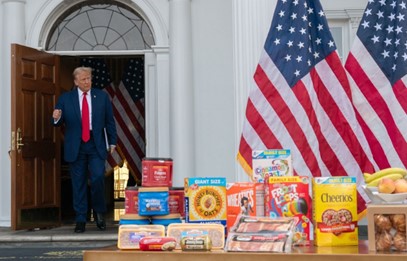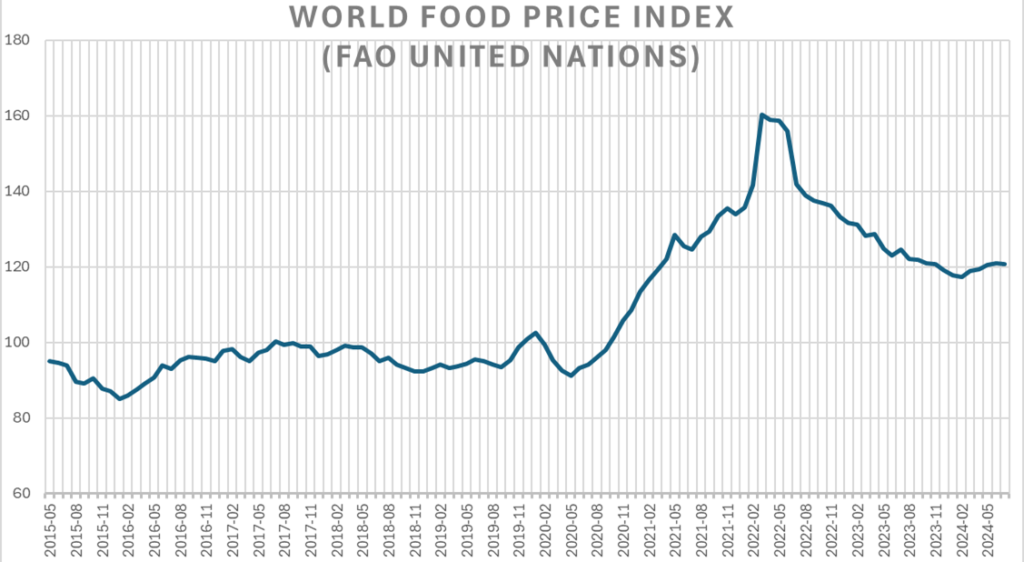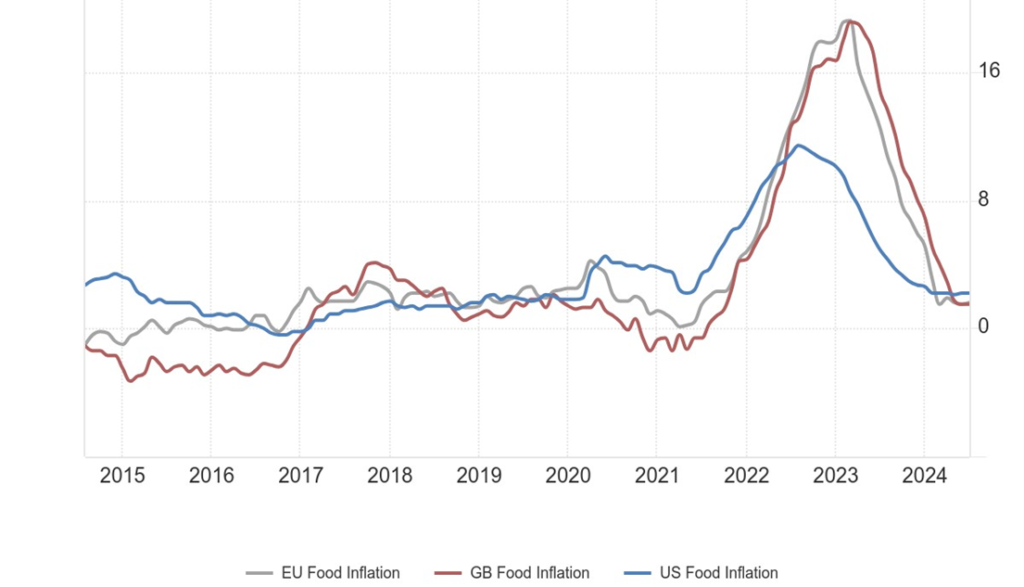
Donald Trump constantly blames Joe Biden, Kamala Harris, and the Democrats for skyrocketing food costs. He says their reckless spending led to crushing inflation, especially as to groceries. For proof, he cites how much prices have gone up since he was President. Speaking to the National Rifle Association in February, he said food “costs 40%, 50%, 60% more than it did just a few years ago.”
As Trump is prone to do, he exaggerates or flat out lies when citing statistics. Trump’s claim quoted above has been debunked and rated as “false” by PolitiFact.
Still, when we research the actual increase in the price of groceries, we find that when Trump was President food prices only increased 5.3%. This compares to a 20.4% increase during Biden’s first three years (see PolitiFact analysis cited above). Assuming we ignore Trump’s bogus numbers, don’t the actual facts allow him to claim credit for low grocery prices during his Administration? And don’t the numbers prove that Biden and Harris are responsible for high prices these last few years?
Logicians and statisticians tell us, “correlation does not imply causation.” By itself, the fact that grocery prices were low during the time Trump was President does not prove he caused low grocery prices. Nor does the fact that grocery prices were significantly higher during the time Biden was President prove that he caused those prices. If we’re going to argue “causation” as Trump is doing, we need to point to specific actions taken by these Presidents. Also, we need to rule out other factors that may have created the food prices that existed during the time they were in office.
So, let’s explore the critical issue of causation. We can do this by first examining and comparing US food prices and worldwide food prices before and during the time Trump and Biden were in office. This will enable us to see trends in food prices, both within the US and internationally, that provide insights into causation. To complete the analysis, we’ll assess the extent to which “Biden’s reckless spending” played a role in creating high food inflation. Was this spending the sole or overriding cause, as Trump claims? Or was it one of several factors that contributed to some extent in creating food inflation?
US Food Inflation Compared with Worldwide, European Union, and Great Britain Food Inflation
To get us started, let me display three graphs. First, I show US food inflation (2015-2024) using Consumer Price Index data from the Bureau of Labor Standard. Second, I show the World Food Price Index (2015-2024) using data from the Food and Agriculture Organization of the United Nations. And third I show US, European Union, and Great Britain food inflation (2015-2024), using data from Trading Economics. Take a moment to compare these three graphs and think about what you see. Then you can compare your thoughts to my analysis.



US Food Inflation:
- US food inflation during the final 2 years of the Obama Administration (2015 and 2016) was very low, even dropping to some negative percentages in the fall of 2016. During the first 3 years of Trump’s term (2017-2019) food inflation remained low, hovering around 2%.
- In May of 2020 (as Covid-19 affected world economies), food inflation went over 4%, reaching a high of 4.5% in June, and remaining around 4% for the rest of Trump’s term.
- Early in Biden’s term (2021), food inflation hovered in the range of 2.2%-3.8%, but went up to 4.6% in September, and climbed to 6.3% by December. In 2022, food inflation continued to climb, from 7% in January to a peak of 11.4% in August. Inflation remained above 10% until January of 2023.
- During 2023, food inflation steadily declined, reaching 2.7% in December. Since February of 2024, food inflation has remained in the range of 2.1% to 2.2%, essentially returning to the food inflation numbers that existed prior to the Covid-19 pandemic.
Worldwide Food Inflation:
- During the period of 2015 to the end of 2019 worldwide food inflation remained low, indexed below 100 (the standard of 100 is based on 2014-16 averages). During Obama’s final 2 years and Trump’s first 3 years, the index hovered in the range of 91 to 98.
- In February of 2020, worldwide food inflation briefly peaked above 100, but quickly returned to below 100. By May 2020, however, a steady ascent began, with the index reaching 130 by the following May, and 135 by the end of 2021.
- In 2022, the index continued to climb strongly, peaking at a record high of 160.2 in March, just a month after Russia invaded the Ukraine. After a few months, the index started declining steadily and averaged 144.7 for the year.
- In 2023, the index continued to decline until stabilizing at around 120 by the end of the year. For 2024, the index has hovered around 120, still higher than pre-pandemic levels.
US, European Union (EU) and Great Britain (GB) Food Inflation:
- During the period of 2015 to 2020 food inflation remained relatively low for all three areas.
- By the spring of 2020, US food inflation climbed and remained higher than the EU and GB well into 2021.
- By mid-2021, all three areas began experiencing steady and significant food inflation, continuing into 2022.
- US food inflation peaked at 11.4% in August of 2022, while EU and GB food inflation peaked seven months later at 19.2% in March of 2023.
- All three areas returned to near pre-pandemic levels early in 2024.
Insights:
- The three graphs closely mirror one another for most of the 10-year period. Both US and worldwide food prices began to increase coincident with the Covid-19 pandemic, beginning around May 2020. Worldwide food inflation went steadily up thereafter, but US food inflation didn’t start to go up steadily until summer of 2021. EU and GB food inflation started increasing around the same time.
- Worldwide food inflation peaked in March of 2022 (index of 160), while US food inflation peaked 5 months later (August) at 11.4%. Both of these peaks are relatively close in time to Russia’s invasion of the Ukraine (February 2022). EU and GB food inflation continued to climb sharply after Russia’s invasion, peaking in March 2023.
- US food inflation began to decline rapidly after August of 2022, and has been at pre-pandemic levels since February 2024. On the other hand, worldwide food inflation declined more gradually and still remains above pre-pandemic levels. EU and UK food inflation declined rapidly after peaking in March of 2023, and have been at pre-pandemic levels since the start of 2024.
- Former President Trump inherited low food inflation that existed not only in the US, but also in the world, the EU, and GB. Food inflation was modest most of his term, but it did jump to 4% during the pandemic (his last 8 months in office, May 2020 to December 2020).
- During President Biden’s term there was high food inflation within the US, worldwide, and in the EU and GB. The increase in US food inflation mirrors the increase in worldwide food inflation and EU and GB during this time. EU and GB food inflation peaked significantly higher than the US. Worldwide, all countries were experiencing high inflation due to supply chain problems, labor shortages, and Russia’s invasion of the Ukraine. Significantly, US food inflation has dropped to pre-pandemic levels (around 2%) for seven months and counting in 2024.
- The patterns of very high food inflation in the 2021-2023 time period are not isolated to the US. Rather, food inflation was spiking all around the world during this time. This suggests that spending by Biden and the Democrats was not the sole or overriding cause of food inflation. Rather, other factors were also at play.
To What Extent Did Biden’s Spending Cause the High Level of Food Inflation in the US?
Let’s accept the prior analysis but keep inquiring about the role Biden’s spending played in creating the high level of US food inflation. To do this we’ll consider Biden’s major spending proposals that became law. We’ll also consider the major stimulus packages enacted during Trump’s term and the effect they may have had on inflation. Finally, we’ll consider other factors that contributed to high inflation, and food inflation in particular.
American Rescue Plan Act
Trump and Republicans especially point to the American Rescue Plan Act (ARP), Biden’s $1.9 trillion stimulus package signed into law on March 11, 2021. ARP provided individual taxpayers $1,400 stimulus payments, along with a $1,400 stimulus payment per child. It also allocated $350 billion to state and local governments, and $130 billion to schools to help them safely re-open for in-person instruction. $300 billion in unemployment benefits were added to extend through Labor Day 2021. There was also an expanded child tax credit. Finally, ARP called for the distribution of $50 billion to small businesses and another $25 billion for relief for small and mid-sized restaurants.
Economists differ on the effect the ARP had on inflation. The right-leaning American Enterprise Institute (Michael Strain) estimated the law added 3 percentage points to inflation in 2021. The left-leaning Center for Economic Policy Research (Dean Baker) found ARP’s effect was a more modest 1-2 percentage points.
PolitiFact examined the claim that Biden’s spending sent prices skyrocketing and concluded:
“The 2021 American Rescue Plan Act added about $1.9 trillion to the economy, and economists across the political spectrum say that it spurred inflation. They differ on the precise scale of its impact, with estimates ranging from two to four additional points out of the current inflation rate of about 8.5%. However, none of the experts we reached, liberal and conservative, said Biden’s actions were responsible for all of the inflation. Past government spending, COVID’s disruptions to labor markets, energy prices and supply-chains also played significant roles. Most recently, the war in Ukraine has made a challenging situation worse.”
Trump’s Stimulus Packages—The CARES Act and the Consolidated Appropriations Act
Trying to estimate the inflationary impact of Biden’s spending is complicated because major stimulus packages adopted during Trump’s term also had an effect on inflation. The CARES Act was a $2.2 trillion stimulus package signed into law on March 27, 2020. Funding had to be obligated by September 30, 2021, and liquidated by December 31, 2021.
Also, a final stimulus package, the Consolidated Appropriations Act, was signed on December 27, 2020, shortly before Trump left office, and just 74 days before Biden signed the ARP. This Act provided some $900 billion in stimulus spending for the 2021 fiscal year, again which had to be obligated by September 30, 2021, and liquidated by December 31, 2021.
Other Biden Spending—Infrastructure Investment and Jobs Act and the Inflation Reduction Act
The Infrastructure Investment and Jobs Act provided an additional $550 billion in newly authorized funding for a wide range of infrastructure projects. It was signed into law on November 15, 2021. However, most of these funds were not allocated quickly, as projects have to be submitted and selected over the period of fiscal years 2022 through 2026. Thus, this legislation had little to no effect on inflation and spending in fiscal years 2022 and 2023.
The Inflation Reduction Act also provided some $891 billion in authorized spending over a multiple year period. The Act was signed into law on August 16, 2022, which is after US inflation peaked at 9.1% in June. As of November 2023, $400 billion was committed to some 40,000 projects. Again, this legislation had minimal effect on inflation and spending in fiscal years 2022 and 2023. And, by 2024, the US inflation rate is holding fast at close to pre-pandemic levels.
We can thus conclude that the three stimulus packages (CARES Act, Consolidated Appropriations Act of 2021, and the American Rescue Plan Act contributed somewhat to high inflation. The St. Louis Federal Reserve found that the combined packages contributed about 2.6 percentage points to inflation. Thus, high food inflation was not largely Trump’s or Biden’s fault.
What actually caused high inflation and high food inflation in the United States?
Trump falsely blames Biden and Harris for causing high inflation and particularly high food inflation. Research tells us that multiple factors contributed to high inflation and high food inflation in the US and other world countries. Here are the major causes:
- Supply chain problems associated with the Covid-19 pandemic and the shutdown of world economies
- Disruptions to labor markets and energy prices associated with the pandemic
- Russia’s invasion of the Ukraine
- Stimulus packages enacted during both the Trump and Biden Administrations
- The Federal Reserve waited too long before raising interest rates in 2022. Inflation got too high.
- Profiteering or “greedflation” by corporate America, particularly with respect to gasoline and food prices. My research revealed that corporate profits were historically high in 2022 and 2023, and drove over half (53%) of inflation.
So what’s the big deal; don’t all politicians stretch the truth to give themselves credit and blame their opponents?
Trump is not breaking any laws in spreading falsehoods about himself or his opponents. And most of us would concede that politicians tend to stretch the truth and cherry pick facts to make their points. Trump, I would argue, exaggerates and lies far more than most. But he and other politicians are free to do so.
Exposing the lies and falsehoods, however, is essential to informing Americans and enabling us to make better decisions regarding the leaders we elect. And, just as important, exposing falsehoods prompts us to question the efficacy of our dysfunctional hyper-partisan political system. Let me elaborate on these two points.
Knowing that Trump falsely takes credit for low inflation and wrongly blames Biden and Harris for high inflation provides critical information for voters. Trump may not be better on the economy. Biden and Harris may be doing a better job than we originally thought. Maybe we are blaming Biden and Harris for something they didn’t create and have little power to control. How do we feel about being lied to and deceived by Trump? And, now that we understand the multiple causes that went into creating high inflation, which candidate will be most able to take on these various causes?
Understanding that the problems we face are complex and multi-faceted is the first step to breaking away from our hyper-partisan political system. Our politicians and political parties tell us that the other side is wrong and evil. They distort causation to take credit for positive developments and blame their opponents for conditions they had little role in causing. They tell us the solution is to vote the bad and entirely-to-blame opponent out of office. But will it solve the problem?
Once we understand that high inflation was caused by multiple factors, we can see the fallacy of voting someone out of office for something they had little role in causing. Our struggles with high inflation and grocery prices are not going to be solved by simply electing the better liar. If we actually want to solve the problem, we’ll need to pick a leader who can help us avoid wars, lead us through pandemics and other emergencies, work with the Federal Reserve, and pressure corporate America to be responsible regarding profit margins.
It’s hard not to blame someone when we’re stressed and angry about grocery prices. Trump’s narratives give us a culprit, but they don’t solve the problem. Instead, we need to be better informed about problems and their multi-faceted causes. This will enable us to break away from the politics of division. Finding middle ground becomes possible when we understand problems in their complexity and stop viewing one another as enemies with irreconcilable views. We are better served by leaders who tell us the truth, help us understand problems in all their complexity, don’t demonize the other side, and who work to find middle ground instead of forcing their will. And you get to choose that leader in November.
Leave a Reply